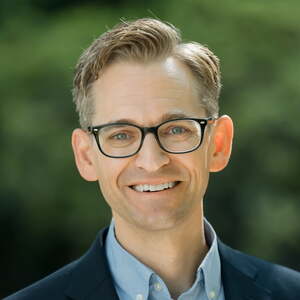
One of the most recognizable architectural features on Biola University’s campus is the large circular beacon that glows brightly atop the library at night. As the highest point on campus — visible from many points across the university — it’s also one of the most meaningful, with its light serving as a prominent and continual reminder of Biola’s calling to be a light to a dark world.
For Ken Bascom (’72), the man who envisioned the beacon and so many other significant elements of Biola’s campus, it was a calling he took seriously. For more than four decades, Bascom — who passed away unexpectedly on June 25 at the age of 62 — played a crucial role not only in improving and developing Biola’s campus, but also in modeling to others what it means to follow Christ.
“One cannot walk these beautiful campus grounds without seeing the physical marks of Ken’s giftedness everywhere,” Biola President Barry H. Corey said soon after the news of Bascom’s death. “But far more profound is the godly and gracious influence he has had on countless people over many decades.”
An alumnus with deep family ties to the university, Bascom devoted much of his life furthering Biola’s mission — not least by helping to build and beautify the university’s physical campus. In his role as senior director of facilities planning and construction, he oversaw the construction of more than 600,000 square feet of new buildings in the past dozen years alone, including the library, Hope Hall, Horton Hall, the Crowell School of Business building and the recently completed parking structure and Talbot East building.
Bascom’s connections to Biola dated back to the school’s earliest days. His grandmother took classes at the original Bible Institute of Los Angeles in 1914 (six years after its founding), and his parents, Harry and Alma Bascom, met at Biola in 1947. As a third generation student, Ken met his wife, Greer, in the summer of 1968. The couple married in 1970, and later had two children, Joel and Faith, both of whom graduated from Biola and married Biola graduates. All told, Bascom had 39 relatives who attended Biola over the past century. (The family was honored with a Legacy Award from the Alumni Relations office during the university’s centennial year in 2008.)
Bascom’s career at the university began in 1970, when he was hired as a 20-year-old student worker on the facilities grounds crew. Though he had originally planned to go into teaching — earning a B.A. in history from Biola in 1972 and an M.A. in history from California State University, Fullerton — he decided to stay in facilities and eventually moved into the department’s administrative offices as the first “campus coordinator.” From there, he became involved in planning and managing the construction of several significant projects, including the redevelopment of the creek and the completion of Metzger Hall.
Other significant projects followed, including the university’s well-known Bell Tower in 1986, Thompson Hall and the Welch and Li apartments in 1991, and the library in 2001. The past decade in particular brought unparalleled growth to campus, with Bascom playing an essential role in the design, approval and construction process of several major facilities and renovation projects.
“What you build says a lot about who you are,” Bascom told Biola’s Inside Story newsletter in 2010 on the occasion of his 40th anniversary at the university. For Bascom, the desire to reflect Biola’s values in its building projects meant being a wise steward of resources, planning well to meet the needs of future generations, and incorporating artistic elements to inspire spiritual reflection.
The Talbot East building, for example, includes “Scripture windows” with etched letters that project verses onto the walls as sunlight streams in, “bringing God’s Word literally into the building in a very real way,” in Bascom’s words. Other touches in the building included stone quarried in Israel and a rooftop garden that both encourages community and helps to keep the building cool.
“His construction projects blended knowledge of theology, art, bricks and mortar, and the needs of students, faculty and staff — along with the wisdom to create a collection of buildings that wonderfully serve the mission of Biola now and will for decades to come,” said Greg Balsano, vice president of university services, Bascom’s longtime supervisor.
Bascom’s contributions to Biola extended far beyond his official role.
He was a resident historian who sought to keep the university connected to its heritage, whether by giving public presentations, writing historical articles, offering campus tours or helping to establish the library’s museum-like Heritage Room. He was a worship leader who led singing at employee meetings and took joy in introducing the community to little-known hymns.
He also played an instrumental role in defining the school’s future for years to come by serving as co-chair of the search advisory committee that selected President Corey as the university’s eighth president in 2007 — making Corey the fourth Biola president under whom Bascom served.
On July 1, Corey welcomed hundreds of people to a standing-room-only memorial service in Sutherland Auditorium to honor Bascom’s life of service.
“Nobody loved Biola more or knew Biola better than Ken Bascom,” wrote Biola’s Board of Trustees chair, Stan Jantz, in a tribute read at the service. “I don’t know why he left us now; none of us do. However, this much I do know: In the economy of God’s great eternal construction project, Ken is at perfect peace, enjoying the heavenly campus Jesus has prepared just for him.”
 Biola University
Biola University
.jpg)

